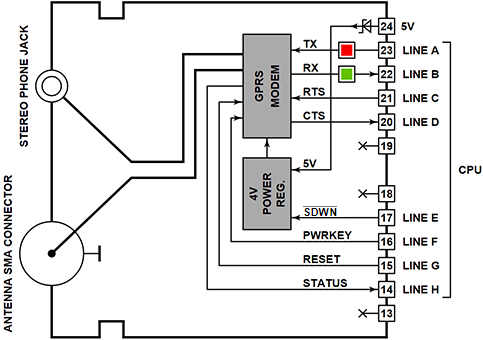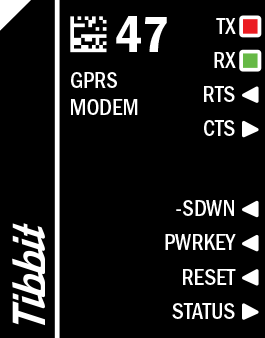#47, H2: GPRS Modem [DEPRECATED]

THIS TIBBIT HAS BEEN DEPRECATED, USE TIBBITS #45 AND #46 INSTEAD
Function: GPRS modem
Form factor: H2
Category: Input/output module
Special needs: [SER]
Power requirements: 5V/300mA average, spot current consumption reaches 1,500mA
Mates with: ---


As of the time of this writing, GPRS support has been disabled on most cellular networks (although there are still a few places in the world that allow GPRS).
We recommend Tibbit #45-1~3 and Tibbits #46 for all new projects requiring cellular communications.
Details
This Tibbit is based on the SIM900 GPRS modem manufactured by SIMCOM. The Tibbit is implemented as an H2 hybrid device. An external antenna (not included with the Tibbit) connects to the SMA type connector located on the front of this hybrid Tibbit. The use of an external antenna is a must — the Tibbit will not be able to operate without it.
There is also a standard stereo phone jack, which can accommodate regular mobile phone headsets. With the right application controlling the modem through AT commands, this Tibbit can make voice calls as well!
The modem has standard TX, RX, RTS, and CTS signals, plus several additional lines.
The –SDWN (shutdown) line, when LOW, turns off the power regulator of the Tibbit. When the line is switched HIGH, the power regulator is re-enabled, but the modem remains in the off state. Toggle the PWRKEY line (see below) to turn on the modem.
The PWRKEY (power key) line toggles the power on and off. A HIGH-to-LOW transition on this line flips the power: turns the Tibbit on if it was off and off if the Tibbit was on. This control method is highly inconvenient, but is somehow used on all GPRS modems. There are two methods of finding out whether the modem is currently on or off: by sending an AT command and checking for a response or by querying the state of the STATUS line (see below).
The RESET line is active HIGH. Bringing the line HIGH for about one second resets the modem. There is no need to reset the Tibbit after turning on its power.
The STATUS line is LOW when the modem is off and HIGH when the modem is on. The line can be used to check the current power state of the modem.
SIM Card Slot
The SIM card holder is located on the bottom of the Tibbit. This means that in order to insert or remove the SIM, you must first open up the TPS and then remove the Tibbit from the Tibbo Project PCB (TPP). We chose this relatively inaccessible SIM card location to lower the chances of the SIM getting stolen. While it is still possible to get to the SIM card, doing so requires quite a bit of time and work, thus making it impossible to remove the card "in a flash."
LEDs
There is one red and one green LED. The red LED is connected to the TX line, while the green LED is connected to the RX line. The remaining lines are not equipped with LEDs because of board space constraints.
Power Considerations
Tibbit #47 consumes a modest average current of 300mA, but has a peak current consumption of 1.5A. The current "spikes" are so narrow that they can't be seen on a regular multimeter. Nevertheless, they are present and occur regularly when the GPRS link is established. To prevent reboots and unstable operation, make sure that you use an adequate power source.
The Tibbo Project System (TPS) platform offers several power supply Tibbits capable of providing the required surge current — Tibbit #23 (PoE), #25 (12/24/48V), and #33. Tibbit #25 will only be able to sustain the GPRS modem when powered from the 24V or higher voltage. Tibbit #33 is recommended for most applications.
GPRS Library and Sample Project
The easiest way to incorporate Tibbit #47 into your project is by using our official GPRS Library. We've published a small project that illustrates the use of this library. You can find it here: http://tibbo.com/basic/resources/examples/test_gprs_lib.html.
